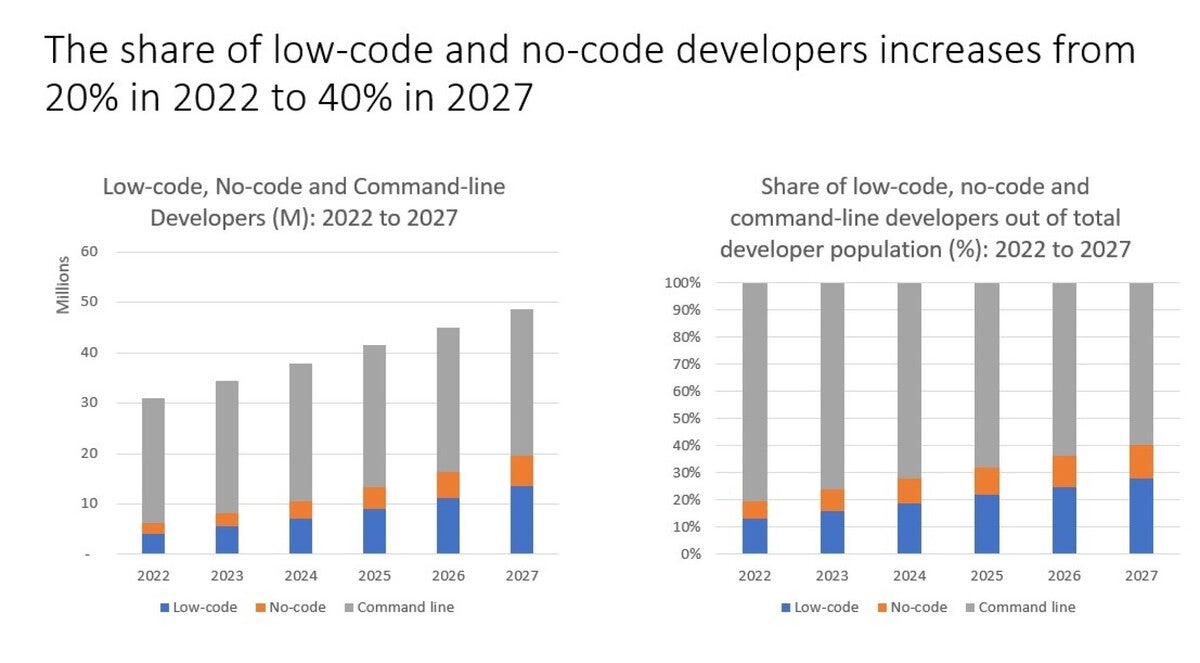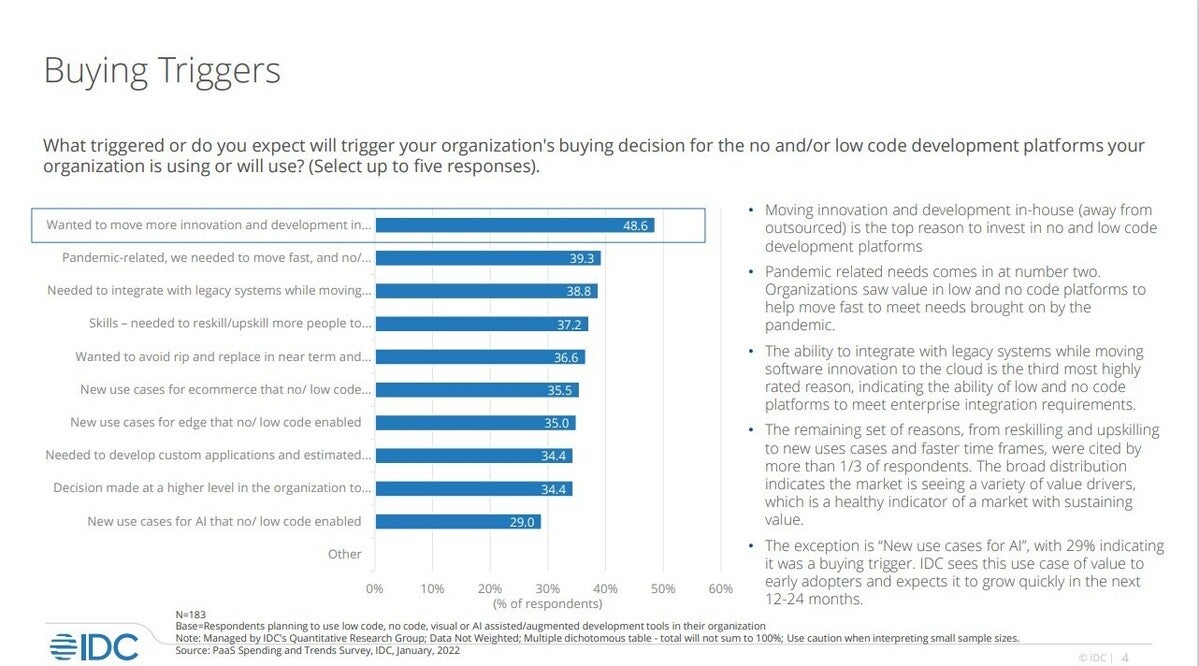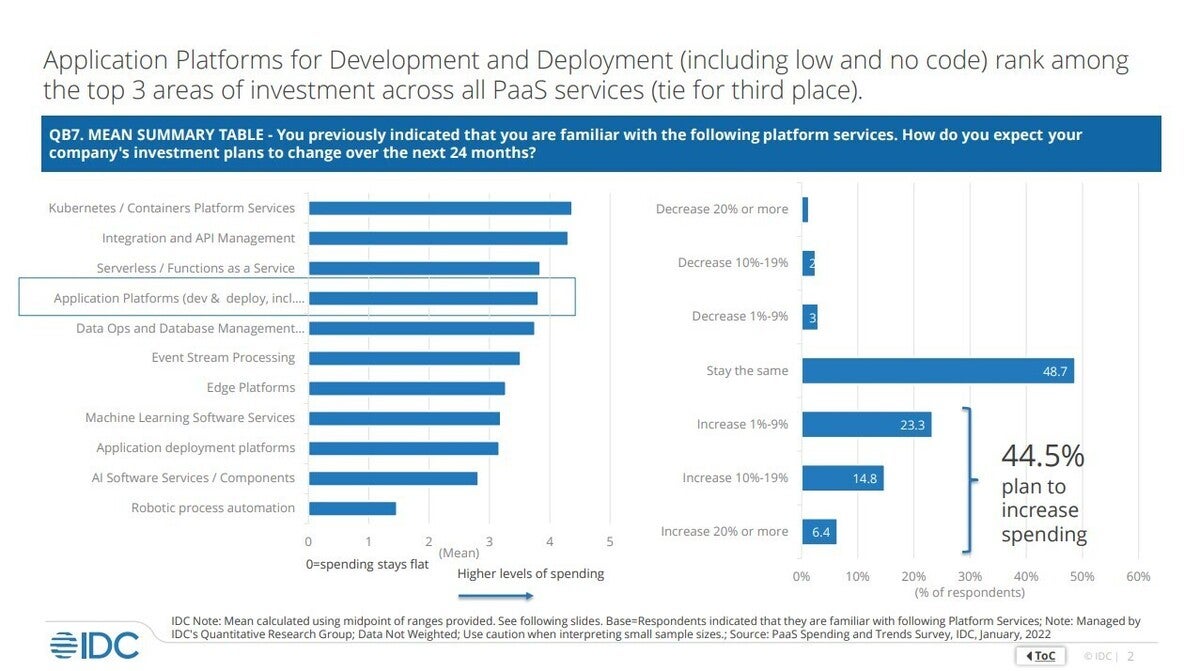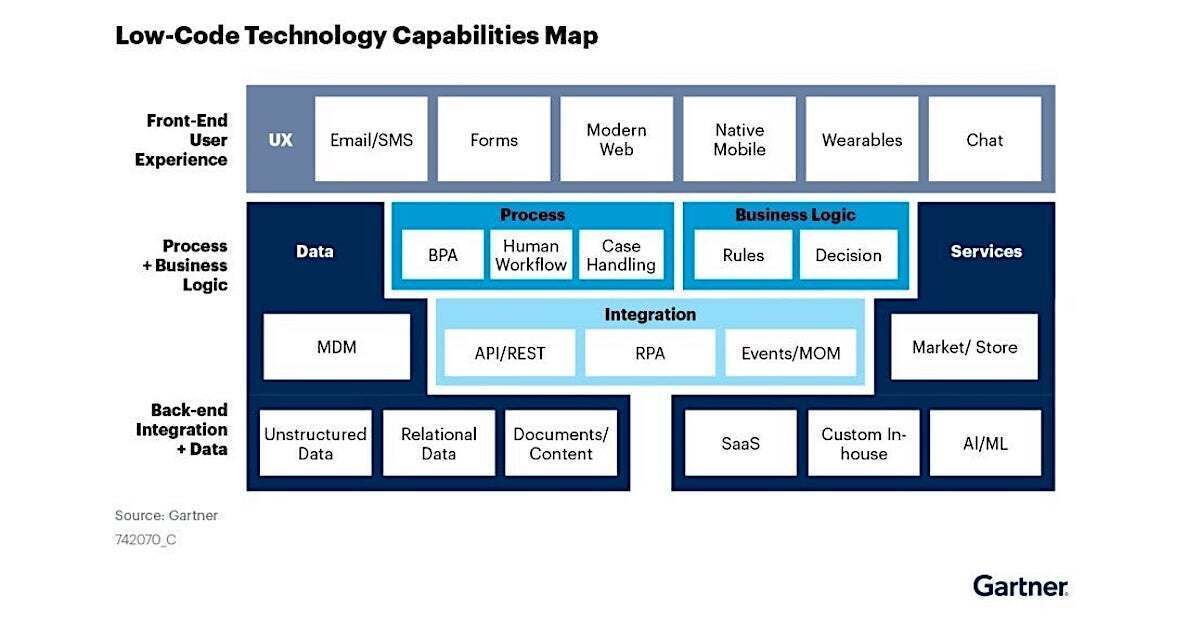With a dearth of skilled developers, more organizations are turning to low-code software development so enterprise users with little formal coding experience can build business apps. But the results aren't always the highest quality.

Low-code development platforms have seen tremendous uptake since the beginning of the COVID-19 pandemic and arrival of the Great Resignation, where droves of workers left their jobs for greener pastures.
The dearth of workers includes software developers, the absence of which has left organizations scrambling to find trained software professionals who can help facilitate business process transformation.
A January survey by research firm IDC of 380 enterprises showed 48.6% of respondents are purchasing low-code or no-code platforms to move innovation in-house. The second-largest reason for purchasing the software tools (39.3%) was “pandemic-related needs.”
“Organizations saw value in low- and no-code platforms to help move fast to meet needs brought on by the pandemic,” IDC said in its report.
 IDC
IDCThe adoption of low-code software development platforms is growing at more than 20% per year, according to research firm Gartner. In 2021, the global market for low-code development technology reached $13.8 billion in revenue. And by 2023, low-code development is expected to be adopted by more than 50% of medium to large companies.
“The economic consequences of the COVID-19 pandemic have validated the low-code value proposition,” Fabrizio Biscotti, research vice president at Gartner, said in a report. “Low-code capabilities that support remote-work function, such as digital forms and workflow automation, will be offered with more elastic pricing since they will be required to keep the lights running.”
According to Morgan Stanley, there is a worldwide shortage of software engineers. There are now 26 million developers in the world, with an expected need for 38 million developers by 2024.
Low-code technology is designed to fill that gap because it allows virtually anyone to be a developer. Gartner predicts that by 2025, 70% of new applications developed by enterprises will use low-code or no-code technologies — up from less than 25% in 2020.
John Bratincevic, a senior analyst with Forrester Research, said while low-code is often associated with “citizen developers,” about one-third of professional developers also use it to simplify development and speed build times.
“And, those developers were also ahead of the non-low code developers in adopting cloud-native technology and advanced use cases. So, they weren’t the dummies. They were doing the cool stuff,” Bratincevic said. “So, even among professional developers, it’s not a niche thing.”
Among the non-professional developers using low-code or no-code development platforms, there’s a spectrum of technical competence, he said. IT analysts, for example, can have the technical chops to use low-code and build serious apps, and the tools eliminate a lot of the complexity in the software stack.
“When you’re looking at business people using low-code, there’s a whole spectrum of interest and experience and platforms that may be easier or harder to learn,” Bratincevic said. “So, the most common question I get from clients is…, ‘How to stand up and scale a well developed citizen developer strategy. How do I do that in a safe and governed way?’
“That’s a hard problem, but companies are working on it. I talk to them all the time. Companies are creating hundreds or even thousands of citizen developers inside their organizations,” he said.
Assuming an organization has people with some expertise in app production who know what the business wants, low-code, no-code options do make it possible to leverage more people for development than by running everything through the DevOps group, said Jack Gold, founder and principal analyst at research firm J. Gold Associates.
“Given that the average queue time for new apps is potentially months or longer, and in many cases only about 15%-20% of requests get completed, being able to get something — even if not optimum, but good enough — in a matter of days perhaps, or even hours, is a huge plus,” Gold said. “It also enables rapid change in business where things can change often and you don’t have time to get app changes done by DevOps.”
“That’s why apps like Microsoft Power Platform have such a great potential to enable apps for organizations that they never would get if they needed a full-blown development effort,” Gold continued. “That’s not to say Power Platform can do everything; it’s very O365-centric, so limited in that regard. But it gives companies a flexibility they wouldn’t have otherwise.”
 IDC
IDCA rising number of low-code platform users
Gartner research said that on average 41% of employees outside of IT — or business technologists — customize or build data or technology solutions themselves. Gartner predicts that half of all new low-code customers will come from business buyers that are outside an IT organization by the end of 2025.
Results from a global survey by Salesforce’s MuleSoft showed 93% of CIOs say the Great Resignation has made it harder to hire skilled developers. And 91% of organizations say they need solutions that automate key processes for developers so they can do more with less.
According to IDC’s data, 39% of 380 enterprise responders plan to use low-code and no-code development platforms over the next two years — and 9% are already using them.
 IDC
IDCAdditionally, application platforms for development of business apps — including low and no code — ranked among the top three areas of investment across all platform-as-a-service providers, according to IDC’s survey. Nearly half of the survey respondents (45.5%) indicated they expect to boost spending on app development during the next two years.
All of the major software-as-a-service (SaaS) vendors currently provide capabilities that incorporate low-code development technologies, according to Gartner. Top low-code vendors include Appian, Retool, Salesforce Platform, Creatio, Oracle Application Express, and ServiceNow App Engine.
“As SaaS grows in popularity, and these vendors’ platforms are increasingly adopted, the low-code market will see commensurate growth in low-code application platforms and process automation tooling,” Gartner said in its report.
Why low-code is now an option
Organizations traditionally had two paths to get business software; they could buy it from a vendor or lease it from a SaaS provider — or they can build it in-house. Like a custom suit, creating a business application internally means it’s tailored to uniquely fit enterprise requirements. It also typically takes longer to create and costs more than just buying software off the shelf, as it were.
Low-code development tools abstract away the more commonly used codebase and replace it with a graphical user interface or visual “what you see is what you get” (WYSIWYG) interface to build an application. “No-code tools simply refers to the abstraction of all codebase into GUIs,” according to Gartner.
Low-code enables business users with little formal coding experience, such as business analysts or project managers, to develop apps, alleviating the need for traditional app developers.
“There are also workers eager for a new skill, and people working from home looking for a career change,” Gartner said. “Many more [are] open to getting involved with tech, but hitting roadblocks such as money for, or accessibility to, proper training and unaware of where the right opportunities are.”
Just this week, low-code development platform vendor Appian launched a free program for low-code education and certification to drive career advancement for developers. The #lowcode4all program guides eligible participants through the steps needed to learn low-code technology and complete an Appian Certified Associate Developer exam.
Digital transformation adds to the pressure to deliver apps
Digital business acceleration is putting pressure on IT leaders to dramatically increase app delivery speed and time to value. The rising demand for custom software solutions to support digital transformation sparked the emergence of citizen developers outside IT, which, in turn spurred the rise in low-code use.
Coming next: the rise of ‘no-code’?
The composable nature of low-code development enables the creation of everything from a data model and business logic to workflows and the user interface (UI). Along with it, another popular development tool is called no-code.
Fundamentally there is really no such thing as “no-code.” First, it implies such tools are for non-professional developers. Developers often use no-code or low-code tools in order to reduce the time it takes to produce software.
No-code is also an inaccurate marketing label, just like Salesforce’s slogan of “no software,” Gartner wrote in a February research note. “There is always code and software running somewhere, just hidden,” Gartner said.
Application and software engineering leaders are bombarded by low-code or no-code tool vendors promising speed and ease of use. And business unit leaders are demanding more of these tools so business technologists (identified as “technology producers”) who do not report to IT can produce apps and automations to meet business needs, according to Gartner.
No-code also does not necessarily mean no technical skills are needed. Tools that are positioned as no-code aim to provide all the building blocks for customers, usually on an ongoing release basis. “These vendors try to offer assembly blocks small enough so that developers can assemble a bigger custom application component if needed, but writing code is not allowed,” Gartner stated. “No-code implies no programming language is used, but even some visual modeling tools require technical expertise or understanding programming metaphors.”
 Gartner
GartnerLow-code development platforms, according to Gartner, support a variety of technologies, including:
- User interface capabilities — The development tool can include support ranging from fixed application user interfaces, communication mechanisms such as email and messaging, simple web and mobile forms, to multi-experience including artificial intelligence (AI)-driven chatbots, augmented reality (AR, and wearables.
- Data — Development technologies usually include data modelling, database or data access technology, or master data management features. Other types of data, such as documents and other content, may also be provided. Prebuilt data schemas may be provided for domain or SaaS compatibility. Many (low-code) platforms only embed a database for their cloud-based offerings, while others require the use of existing data sources.
- Process and workflow — Various types of “processes” may be supported through orchestration or workflow tooling.
- Business logic — Beyond simple scripting of business rules, development tools may explicitly support specific types of business rules and rulesets and their execution, or as decision-based organizations for business logic.
- Integration — Many information sources required in applications exist in external components that need to be accessed via APIs. Other APIs may provide access to event-based APIs or event brokers.
- Services — Low-code development technologies may include various prebuilt services specific to a business or application domain. These services may be blackbox, or include customizable definitions and models.
Gold offered a word of caution when it comes expectations for the usability of low-code/no-code platforms. While many vendors talk about non-professional and citizen developers, it’s really all about users knowing what they want to do and being able to put together a useful piece of software to do it, he said.
An employee can be handed Microsoft Office with Word, Excel and PowerPoint, but if the worker doesn’t know how to write well or create proper spreadsheets, the output is not going to be very useful to anyone else but you, Gold said.
“The bottom line is the low-code/no-code tools provide an opportunity for companies to implement solutions relatively quickly, and to leverage many ‘citizen developers,’ but the quality of those solutions will depend on the ability of the person producing it to define and implement,” Gold said. “The LC/NC created solution may not run as well as a fully coded and optimized solution from a developer, but for many business purposes, ‘good enough’ is fine, and rapid deployment is critical.
“And the ability to make rapid changes as businesses change is a major plus as well.”









